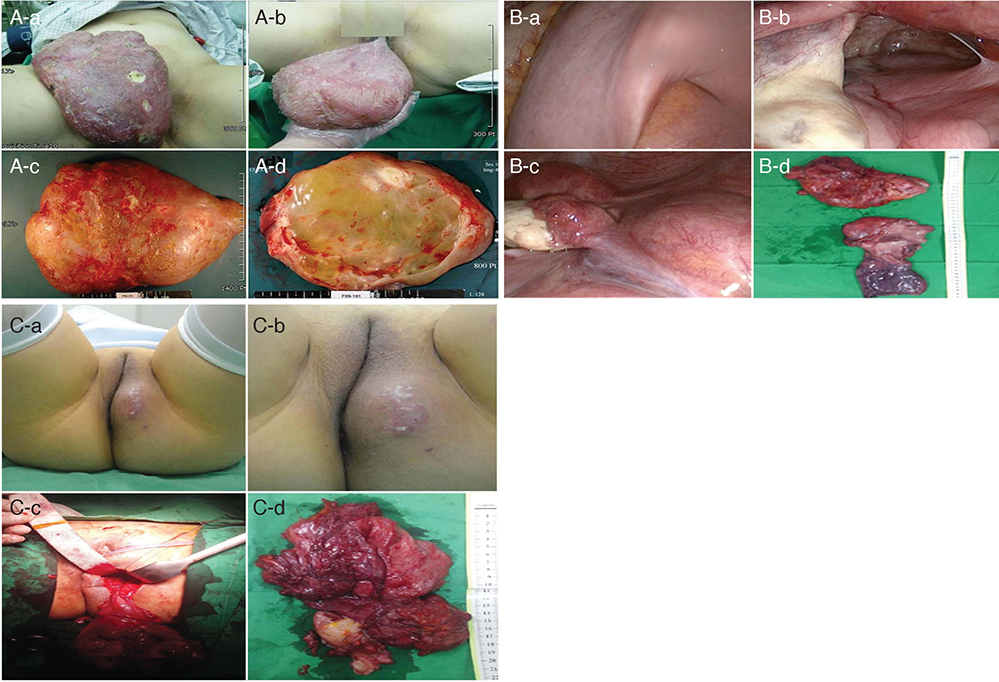Obstet Gynecol Sci.
2015 Nov;58(6):525-529. 10.5468/ogs.2015.58.6.525.
Alternative surgical approaches for aggressive angiomyxoma at different sites in the pelvic cavity
- Affiliations
-
- 1Department of Obstetrics and Gynecology, Inje University Haeundae Paik Hospital, Inje University College of Medicine, Busan, Korea. jyimdog@paik.ac.kr
- KMID: 2314072
- DOI: http://doi.org/10.5468/ogs.2015.58.6.525
Abstract
- Aggressive angiomyxoma, a rare soft tissue benign neoplasm, predominantly occurs in the female pelvic peritoneum and perineum region during reproductive age. It is slow growing, locally infiltrative, and has a high risk of local recurrence and the neoplastic character of blood vessels. The standard treatment is surgery. We report three unusual aggressive angiomyxoma cases. The first case was a pedunculated mass of the left labium major; the second, a left perineal mass that infiltrated into the paravesical area via the obturator foramen; and the third, a big mass in the retroperitoneal cavity, found that growing aggressive angiomyxoma looked like lava expulsion in the pelvic area. After a thorough examination and full radiologic workup, we performed surgical excision in each patient via different approaches. Histopathologic findings were consistent with diagnosis of aggressive angiomyxoma. To date, no relapse has been observed.
Keyword
MeSH Terms
Figure
Cited by 1 articles
-
Robotic extralevator excision of a retrorectal giant aggressive angiomyxoma
Scott R. Kelley
Obstet Gynecol Sci. 2018;61(6):693-697. doi: 10.5468/ogs.2018.61.6.693.
Reference
-
1. Kura MM, Jindal SR, Khemani UN. Aggressive angiomyxoma of the vulva: an uncommon entity. Indian Dermatol Online J. 2012; 3:128–130.2. Dahiya K, Jain S, Duhan N, Nanda S, Kundu P. Aggressive angiomyxoma of vulva and vagina: a series of three cases and review of literature. Arch Gynecol Obstet. 2011; 283:1145–1148.3. Sereda D, Sauthier P, Hadjeres R, Funaro D. Aggressive angiomyxoma of the vulva: a case report and review of the literature. J Low Genit Tract Dis. 2009; 13:46–50.4. Amin A, El Badawy S, Bull A. Aggressive angiomyxoma of the vulva. J Obstet Gynaecol. 2013; 33:325–326.5. Mandal S, Dhingra K, Roy S, Khurana N. Aggressive angiomyxoma of the vulva presenting as a pedunculated swelling. Indian J Pathol Microbiol. 2008; 51:259–260.6. Mathieson A, Chandrakanth S, Yousef G, Wadden P. Aggressive angiomyxoma of the pelvis: a case report. Can J Surg. 2007; 50:228–229.7. Dierickx I, Deraedt K, Poppe W, Verguts J. Aggressive angiomyxoma of the vulva: a case report and review of literature. Arch Gynecol Obstet. 2008; 277:483–487.8. Outwater EK, Marchetto BE, Wagner BJ, Siegelman ES. Aggressive angiomyxoma: findings on CT and MR imaging. AJR Am J Roentgenol. 1999; 172:435–438.9. Nyam DC, Pemberton JH. Large aggressive angiomyxoma of the perineum and pelvis: an alternative approach. Report of a case. Dis Colon Rectum. 1998; 41:514–516.10. Nucci MR, Fletcher CD. Vulvovaginal soft tissue tumours: update and review. Histopathology. 2000; 36:97–108.11. Basak S, Rogers S, Solomonsz AF. Superficial angiomyxoma of the vulva: a case report of a rare cutaneous tumour. J Obstet Gynaecol. 2011; 31:360–361.12. Sun NX, Li W. Aggressive angiomyxoma of the vulva: case report and literature review. J Int Med Res. 2010; 38:1547–1552.13. McCluggage WG, Jamieson T, Dobbs SP, Grey A. Aggressive angiomyxoma of the vulva: dramatic response to gonadotropin-releasing hormone agonist therapy. Gynecol Oncol. 2006; 100:623–625.14. Shinohara N, Nonomura K, Ishikawa S, Seki H, Koyanagi T. Medical management of recurrent aggressive angiomyxoma with gonadotropin-releasing hormone agonist. Int J Urol. 2004; 11:432–435.
- Full Text Links
- Actions
-
Cited
- CITED
-
- Close
- Share
- Similar articles
-
- Aggressive Angiomyxoma in Female Pelvic Cavity: A Case Report
- Aggressive Angiomyxoma at Ischiorectal Fossa
- Aggressive Angiomyxoma in the Vulva: A Case Report
- A case of recurrent aggressive angiomyxoma of the vulva in the adolescence
- Robotic extralevator excision of a retrorectal giant aggressive angiomyxoma



